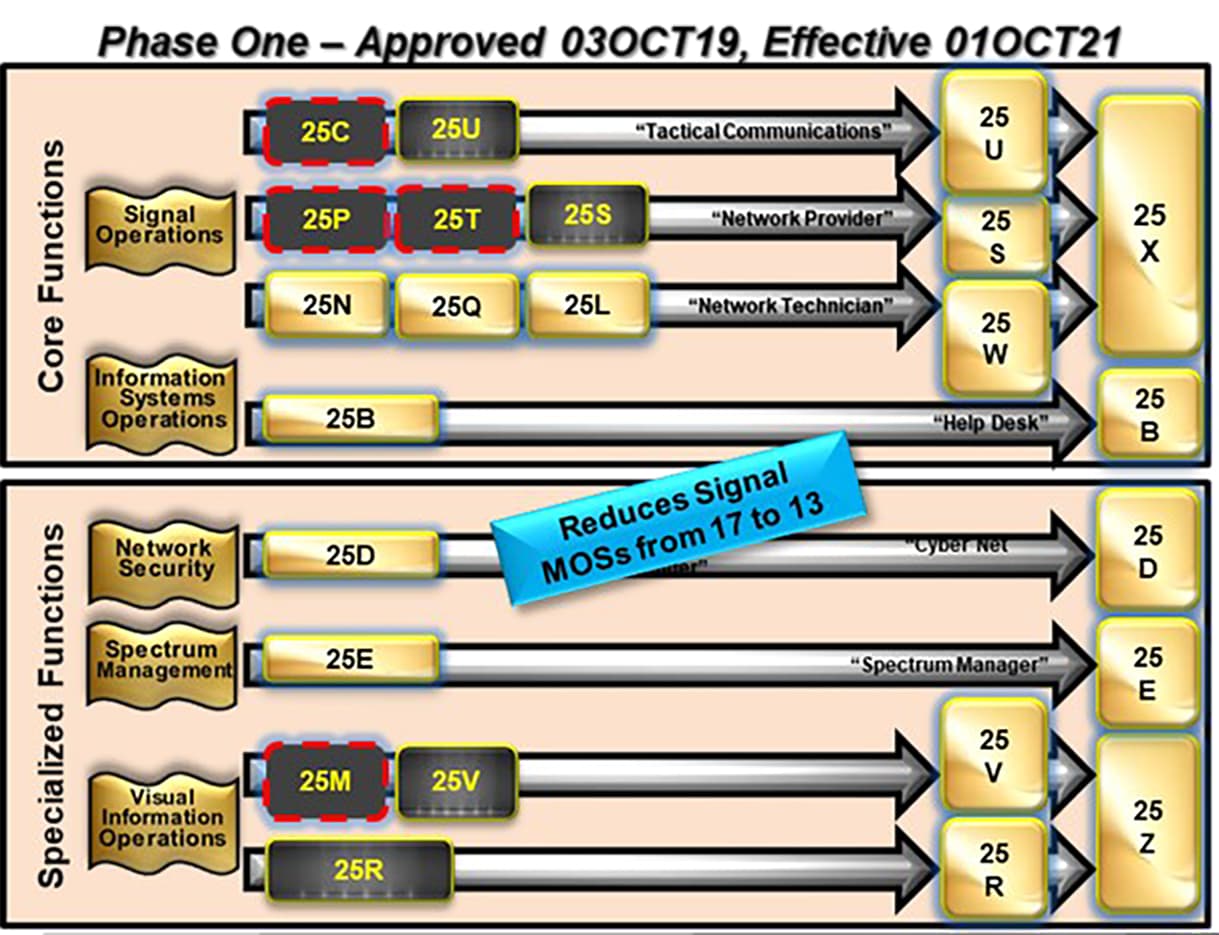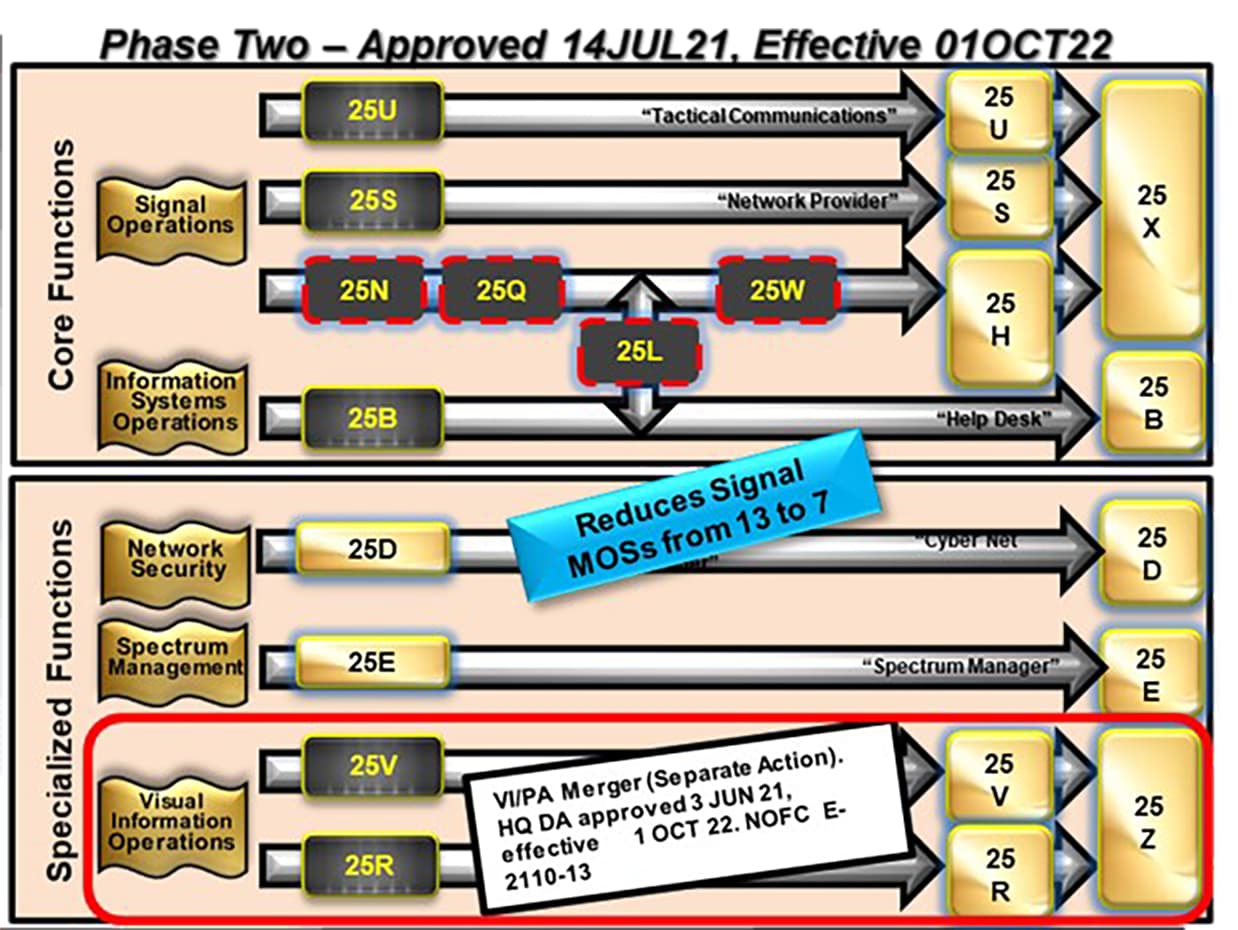Signal Enlisted MOS Convergence Explained
Personnel structure
By Lamar Lauderdale, Office Chief of Signal, U.S. Army Signal School
Article published on: Spring 2024 in Army Communicator spring 2024 Edition
Read Time: < 6 mins

Figure 1. Phase One - Approved 03OCT19, Effective 01OCT21
Starting on Oct. 1, 2021, the Signal Regiment began implementing the most significant change in its enlisted
personnel structure since the mid-1990s.
The Army Strategy’s focus on readiness, modernization, and reforming the Army into a multi-domain operational
force – as well as the shift to the Unified Network and other emerging technologies – created the need to
foundationally change the way we train, employ, and professionally develop Signaleers. The U.S. Army Signal
School developed a Signal Enlisted Military Occupational Specialty (MOS) Convergence strategy to develop
adaptive, multi-disciplined signal Soldiers who can be utilized more efficiently to excel in our current and
future operational environment. The last of the three-phase implementation will take effect on Oct. 1, 2025.
The Purpose
The previous Enlisted Career Management Field (CMF) 25 was not fully postured to enable mission command in the
expeditionary, multi-domain, full spectrum, and large scale combat operational environment of Army 2030 and
beyond. The previous model consisted of 17 MOSs which primarily focused on tasks associated with equipment sets.
The Office Chief of Signal (OCoS) sought to restructure its enlisted MOS structure based on communication
functions. OCoS leveraged input from several subject matter expert panels which determined the most relevant and
most forward-thinking MOS structure.
Signal Enlisted MOS Convergence sought senior signal leader guidance throughout development. The overarching goal
was to streamline the talent management process. The new signal enlisted structure needed to significantly
reduce task redundancy between MOSs. For example, the old Warfighter Information Network – Tactical (WIN-T)
personnel structure required multiple MOSs to perform on the same system. This caused readiness challenges and
limited command flexibility to fill critical personnel gaps. It also foretold future challenges with equipment
scalability. We could not transfer those inefficiencies to signal operations on the Unified Network.
The new CMF 25 structure also needed to eliminate the multiple “capper” MOSs that merged two or more MOSs into
new MOSs at the senior NCO level, which created professional development gaps at the strategic leadership level.
This level of MOS restructuring required analysis of other areas important to the health of an MOS such as grade
structure, physical demands, and impact on recruiting. Ultimately, the MOSs had to realign more efficiently to
support future network needs.
The Process and Challenges
The process to develop the optimal MOS structure involved a set of interconnected decisions involving doctrine,
organization, training, personnel policy, and cost. The Signal School understood that all the actions required
to complete Signal Enlisted MOS Convergence could not be executed all at once; incremental change would lessen
the turbulence. Therefore, OCoS developed a multi-phase approach for execution across multiple years.
It was important to minimize the need for Soldiers to physically attend transition training at Fort Eisenhower,
Georgia. Merged MOSs which had complimentary tasks and functions on the same signal communication systems, or
with largely similar MOS duties, responsibilities, and assignments did not require transition training. The
Signal School created virtual transition courses for 25S (satellite communication systems operator-maintainer)
and 25V (visual information specialist) to keep Soldiers at home station. Additionally, the Advanced Leader
Course and the Senior Leader Course doubled as transition training courses.
Restructuring signal MOSs involved developing new individual critical task lists that encompass the scope of the
changes either by eliminating tasks, adding tasks, merging tasks with another MOS, or creating a new MOS
individual critical task list. Subject matter expert panels were conducted in 2015 and 2017 to review combined
critical tasks and notionally determine: which tasks remain relevant, which tasks are redundant or no longer
relevant, or what tasks should be added or updated based on doctrinal changes.
The first phase of Signal Enlisted MOS Convergence, effective Oct. 1, 2021, reduced the CMF 25 enlisted structure
from 17 MOSs down to 13. MOS 25M merged with MOS 25V to form the revised MOS 25V, which established a visual
information service provider. MOS 25C and MOS 25U merged to form a singular tactical communications service
provider with the revised MOS 25U (signal operations support specialist). Phase 1 also combined MOS 25P, MOS
25S, and MOS 25T to provide a streamline satellite communications service provider with the revised MOS 25S
(satellite communication systems operator-maintainer).

Figure 2. Phase Two - Approved 14JUL21, Effective 01OCT22
Effective Oct. 1, 2022, Phase 2 of Signal Enlisted MOS Convergence further reduced the enlisted CMF 25 structure
from 13 MOSs to seven by combining MOS 25N, MOS 25Q, MOS 25W and the wide area network (WAN) cabling functions
of MOS 25L to create the new MOS 25H (network communication systems specialist), which established a singular
WAN service provider. This action also combined MOS 25B and the local area network cabling functions of the
deleted MOS 25L to create an enhanced information technology service provider.
Skills and knowledges required to perform applicable communications cable and antenna systems maintainer (ASI J2)
and installer (SQI I) duties were incorporated into Signal Foundation training (the Basic Communicator Module),
MOS 25B, and MOS 25H training. In a separate Department of the Army directed action, visual information MOSs
25R, 25V, and 25Z transferred to the Army Public Affairs Center.

Figure 3. Phase Three - Approved 31OCT23, Effective 01OCT25
Phase 3 specifically focused on senior NCO development. Effective Oct. 1, 2025, MOSs 25B, 25H, 25S, and 25U will
merge into the new MOS 25Z (senior signal sergeant) at master sergeant. This action enhances the senior NCO’s
ability to lead signal multi-MOS teams at the organizational and strategic levels and to manage staff elements
within a multi-domain operational environment. The merger of signal’s four accessions MOSs at master sergeant
will increase operational readiness, expand multifunctional capabilities, and add diversity in assignments and
leader development opportunities.
Phase 3 will also change the CMF 25 name from communication and information systems operations to signal. MOS 25S
will change from satellite communication systems operator-maintainer to satellite communication systems
specialist to align its naming convention with signal’s three other accessions MOSs.
MOS development is an ongoing process. The transition period for Signal Enlisted MOS Convergence will take
several years. Feedback through critical task site selection boards, operational Soldier employment, and leader
engagements will allow the Signal School to fine-tune how these new MOSs are accessed and trained. As the Signal
Regiment continues to transform, its personnel structure will continue to change as well to ensure continued
success.